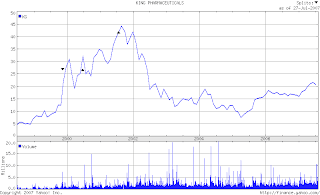 If one views a graph showing the price of King shares over time, it would be easy to assume King is a dot-com company that survived. The price peaked in July 2001 at $46.05 per share, and then it fell 84 percent over the next four years. The lowest closing price was $7.55 in April 2005. The shares bounced back up over $20 fairly quickly, but they have been trading in a range between $16 and $21 for the last year and three-quarters.
If one views a graph showing the price of King shares over time, it would be easy to assume King is a dot-com company that survived. The price peaked in July 2001 at $46.05 per share, and then it fell 84 percent over the next four years. The lowest closing price was $7.55 in April 2005. The shares bounced back up over $20 fairly quickly, but they have been trading in a range between $16 and $21 for the last year and three-quarters.Of course, King is not a dot-com company. It sells brand-name prescription pharmaceuticals, most notably Altace®. This ACE inhibitor, which is used to treat patients with cardiovascular risks, accounts for about 1/3 of King's net sales. Many problems led to King's difficulties in the early years of this decade, including disappointing sales, Medicaid overcharge allegations, and inventory management challenges.
King has put, as far as we know, these problems behind it. But, it now faces a challenge that could be more difficult to surmount: the looming loss of patent protection on Altace and other key products.
King has been achieving good scores on our gauges of late. After the first quarter of the year, the Overall Gauge read a strong 59 points. In our accompanying analysis, we fretted that the gauges were giving too much credit to the company for the rebound that had already occurred. We noted that earning increases were more attributable to lower "special charges" (e.g., asset impairment) than improving core operations.
As a result, we will carefully examine the second quarter results to get another read on how well the company is really performing. We will also be looking for clues to their strategy for dealing with the patent expiration concerns.
The 2005-2006 recovery resulted in strong Revenue growths, which have since abated. Revenue in the four quarters that ended in March 2007 was only 7 percent greater than in the four preceding quarters. We're assuming growth won't slow much more until patents actually start to expire. Therefore, our estimate for the second quarter Revenue is $535 million. This value is 7 percent greater than revenues in the June 2006 quarters. Coincidently, it also equates to year-over-year revenue growth of 7 percent.
Like most specialty drug manufacturers, King achieves eye-popping Gross Margin figures: values over 80 percent of revenue are not unusual. Recently, the Gross Margin has been somewhat below 80 percent, and our expectation for the second quarter is a still-lucrative 77 percent. This would result in a Cost of Goods Sold (CGS) of 23 percent of $535 million, or $123 million.
It seems reasonable to assume that Depreciation and Research and Development (R&D) expenses will each be about 7 percent of revenue, or $37.5 million apiece. Depreciation as percentage of revenue has been slowly declining, and R&D has been slowly increasing, and the two figures, for whatever reason, seem to have met in the middle.
Sales, General, and Administrative (SG&A) expenses seem have stabilized at 35 percent of revenue, which would be $187 million if our revenue estimate stands up.
King often has takes special operating charges that determine the quarter's success. The charges range, in no particular pattern, between negligible and huge. We're going to assume a $20 million charge in the second quarter, which is significant, but not even half the charge as recently as December 2006. (Note: many earnings estimates do not take these charges into account.)
Our estimates would lead to Operating Income of $130 million.
Non-operating income has recently been about $7 million per quarter. If the Income Tax Rate (another fluctuating parameter) is 33 percent, Net Income would be $92 million.
| ($ M) | June 2007 (predicted) | June 2006 (actual) | |
| Revenue | 535 | 500 | |
| Op expenses | |||
| CGS | (123) | (107) | |
| Depreciation | (37) | (39) | |
| R&D | (37) | (35) | |
| SG&A | (187) | (154) | |
| Other | (20) | (0) | |
| Operating Income | 130 | 165 | |
| Other income | |||
| Investments | 0 | 0 | |
| Interest, etc. | 7 | 5 | |
| Pretax income | 137 | 170 | |
| Income tax | (45) | (59) | |
| Net Income | 92 | 111 | |
| 0.37/sh | 0.46/sh | ||



